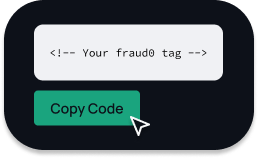Protect your marketing & analytics from invalid traffic
Bots and invalid traffic waste billions in ad spend every year. Automatically detect and exclude fake traffic and keep your analytics clean.

Protecting thousands of websites and advertisers every day
How fraud0 works
Real-time Invalid Traffic Detection
- Works across all traffic source
- Detects bots, fake users, click farms etc.
Automated Protection
- Stops bad traffic before it hits your bill
- Automatically takes action — in real time
Accurate Data, Wiser Decisions
- Cleans your analytics data for real insights
- Connects directly to Google Analytics
3 easy steps. 5 minutes of your time. Full protection.
Step 1
Create your fraud0 account

Step 2
Copy & paste our tag to your website

Step 3
Connect fraud0 to your systems

Our Customers Love Us
“fraud0 detects the bots on our website and helps us to initiate appropriate measures.”

Mark Ngauv
Managing Director / CMO @ RUFF CYCLES
“A single line of code on our website gives us visibility on how much fake traffic we are buying. Transparency and efficiency with fraud0 rocks!”

Lena Heil
Senior Digital Marketing Manager @ Merz Aesthetics
“Great tool to increase performance. Real impact in just a few weeks. No-brainer.”

Alexander Geißenberger
Founder & CEO @ XPOSE360

“Easy to implement cybersecurity software. It helps us in keeping our sales funnel clean by flagging bot-generated leads and stops loading onsite tools.”

Mischa Rürup
Co-Founder @ Usercentrics
“Must have tool for every marketeer. fraud0 is giving us cleansed analytics data on key metrics such as our consent opt-in or invalid traffic rate.”

Tim Schmid
Managing Director @ Avantgarde pmc

“Great software. And interesting to see what a single line of code reveals about the traffic quality on our sites!”

Saif Jarad
Founder & CEO @ Chain Reaction
“Eye opening! Our paid campaigns were hit by 19% of fake traffic. fraud0 gives us back control. Great software.”

Felix Koleber
Co-Founder & CEO @ Levia Blanket

“fraud0 is easy to implement and to use. Awesome team, helps us to protect our audience and placements from bots.”

Martina Rinner
Head of Online Marketing @ Forum Verlag Herkert GmbH
Featured by


